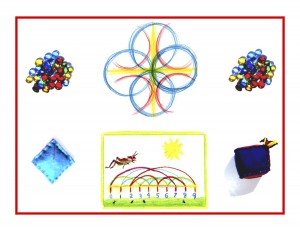Day 59
For one year, 365 days, this blog will address the Common Core Standards from the perspective of creating an alternate, ambient learning environment for math. Ambient is defined as “existing or present on all sides, an all-encompassing atmosphere.” And ambient music is defined as: “Quiet and relaxing with melodies that repeat many times.”
Why ambient? A math teaching style that’s whole and all encompassing, with themes that repeat many times through the years, is most likely to be effective and successful. Now it’s time to meet the numbers! Of course, by age 6-7 most children already know numbers and counting. But Grade 1 offers an opportunity to formally introduce them through content-rich lessons that are built on stories, pictures, and movement.
The Common Core Math Standards for Grade 1 rigorously plunge into abstract calculation in addition and subtraction, having laid the groundwork in Kindergarten and in some cases Pre-Kindergarten. Though a lot of the Common Core math early childhood curriculum tends to be healthily mixed with play, hands-on learning, and movement, much of the academic content remains too direct and thoroughly age-inappropriate. A five year old made to sit down and fill in workbook pages for hours on end is not fulfilling any good purpose, including and perhaps primarily, an academic one.
A truly healthy, holistic math curriculum however, following the solid pedagogical tenets of Piaget, Dewey, Steiner, and Montessori paces the immersion into math slowly, carefully, and broadly. Such is the Waldorf approach. So, after the form drawing block (with form drawing brought back every Monday, all year) the numbers from 1-12 are introduced through fairy tales. The essence of the number is conveyed through the story. A story about the sun or moon might be told for the number 1 as an example of singleness or oneness, while relating the number 1 to the uniqueness of each individual as well.
The week could be structured like this. A vigorous, lively 20 minutes or so of recitation, rhythmic movement, and singing first thing, every morning, followed by the 1 1/2 – 2 hour main lesson: Monday, form drawing, then the story for the number 1 is told. Tuesday, the story is retold by the child(ren), illustrated and captioned with the number 1 drawn large and carefully on the facing page, then the story for the number 2 is told. This rhythm continues until the number 12 is reached.
Each day is layered with alternating in and out breaths, beginning with the circle as an out-breath. The story and illustration, as in-breaths, are followed by a lively play break and nutritious snack. Skills practice could come next for 20 minutes or so, then lunch. And a wonderfully free afternoon of handwork, gardening, cooking, field trips, fun! This sort of alternating schedule really does mimic breathing, with quiet listening or working as breathing in, and playing or lively movement as breathing out.
Compare this to a full, 6 or 7 hour day of seat work, as so many Kindergarten children are enduring in the administration’s effort to cover all the ground required by the new standards. Let’s get back to basics! And get on track for slow learning, as a haven and respite from the hurried, harried pace endured by all these days. For knowledge ensues in an environment dedicated to imaginative, creative knowing, where student and teacher alike surrender to the ensuing of that knowledge as a worthy goal. See you tomorrow for more Grade 1 numbers . . .












